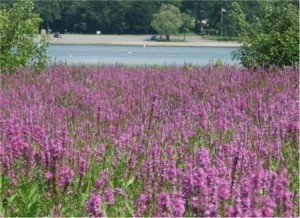(Lythrum salicaria)
Purple loosestrife is a wetland perennial native to Eurasia that forms large, monotypic stands throughout the temperate regions of the U.S. and Canada. It has a vigorous rootstock that serves as a storage organ, providing resources for growth in spring and regrowth if the plant has been damaged from cuttings. New stems emerge from the perennial roots enabling the plant to establish dense stands within a few years. Seedling densities can approach 10,000-20,000 plants/m2 with growth rates exceeding 1 cm/day. A single, mature plant can produce more than 2.5 million seeds annually which can remain viable after 20 months of submergence in water. In addition, plant fragments produced by animals and mechanical clipping can contribute to the spread of purple loosestrife through rivers and lakes.
A. Hand Pulling/ Grubbing:
In small populations, younger plants (1-2 years old) can be pulled by hand. Plants more than 2 years old should be dug out with special care to include the entire rootstock. Use of tools, such as a Weed Wrench, on plants once they have developed a woody cane can be an effective way to remove this rootstock. Plants should be removed before flowering to ensure that seeds are not dispersed during the disturbance. All plant parts should be carefully bagged, removed from the site, and placed in approved landfills or preferably burned to prevent escape to other non-infested sites. In addition, clothing, boots, and equipment should be properly cleaned to ensure that no seeds are transported. Follow-up treatments of sites are recommended for 3 years to eliminate re-sprouts from fragments left behind.
B. Cutting:
Hand tools may be used to cut plants, particularly younger plants (1-2 years old) which have not yet developed woody stems. Since these tools mow the plants and leave the root structures intact, repeated cuttings may be necessary over the course of a growing season. All plant parts should be removed immediately from the site and properly disposed of. Once severed, stems are buoyant and may disperse to other areas and re-sprout.
Purple loosestrife produces a huge volume of seeds that contribute to the seedbank in the soil. In areas where this plant is expanding and removal is not feasible, cutting the flowers off with common garden clippers or shears can dramatically slow the spread of seeds. Again, all plant parts that are cut should be bagged and removed from the site to prevent re-sprouting.
C. Mowing:
Mowing is not recommended for purple loosestrife because it can further spread the species by distributing plant stems that will sprout vegetatively. If feasible, native plants should be restored to the control area by seeding or planting. This re-establishment of vegetation will deter new loosestrife seedling development.
D.Biological Controls:
Several insects that feed specifically on purple loosestrife in Europe have undergone intensive laboratory and field tests in the U.S. To date four insects have been approved for release in Connecticut.
Two leaf-eating beetles, Galerucella calmariensis and G. pusilla defoliate purple loosestrife, leaving behind dried out skeleton of the leaves. By defoliating large portions of the plant, these beetles impact the plant’s ability to photosynthesize. This type of stress reduces the plant’s ability to store reserves for overwintering and limits its capacity to form flowers. Beginning in 1996, Donna Ellis at the University of Connecticut has released Galerucella beetles at several study sites in Connecticut as part of a long-term research project. The beetles are causing extensive feeding damage to purple loosestrife at the release sites, and they have been overwintering and reproducing successfully.
Hylobius transversovittatus is a weevil that attacks the entire plant. Adults feed on aboveground portions of purple loosestrife, while the larvae attack the roots and crown of the plant. By attacking the rootstock, Hylobius weevil larvae affect nutritional uptake and the plant’s ability to overwinter and survive during stressful conditions.
Another weevil, Nanophyes marmoratus, attacks the flowers of purple loosestrife. Upon emerging, overwintering adults move to young plants and feed on the newly developing leaves. After flowering is initiated the adults move to the flower spike and feed on the opened flowers located on the bottom of the spike. Adults feed exclusively on the flowers. Long-term effects should be significant since feeding action and oviposition prevent normal flower development thereby limiting seed production.
E. Herbicides:
In dense, monotypic stands of purple loosestrife, spray loosestrife seedlings before they reach 12″ tall with glyphosate. For established loosestrife growing from perennial rootstocks, spray glyphosate when loosestrife is actively growing from full flowering to just after flowering (late summer to early fall, before frost). Use Rodeo formulation if loosestrife is growing in standing water or if spray will contact water.
ROUNDUP [glyphosate (41%)]: 2.5 fl. oz./gal
RODEO [glyphosate (53.8%)]: 2 fl. oz./gal
References
Heidorn, R. and B. Anderson. 1991. Vegetation management guideline: Purple Loosestrife (Lythrum salicaria L.). Natural Areas Journal 11(3) 172-173.
Malecki, R.A. and Rawinski T.J. 1985. New methods for controlling purple loosestrife (Lythrum salicaria). New York Fish and Game Journal 32(1) 9-19.
Noxious and Nuisance Plant Information System, Version 4.0.
Tennessee Exotic Plant Management Manual, April 1997.
For more information about biological control of purple loosestrife, contact: info@cipwg.org
